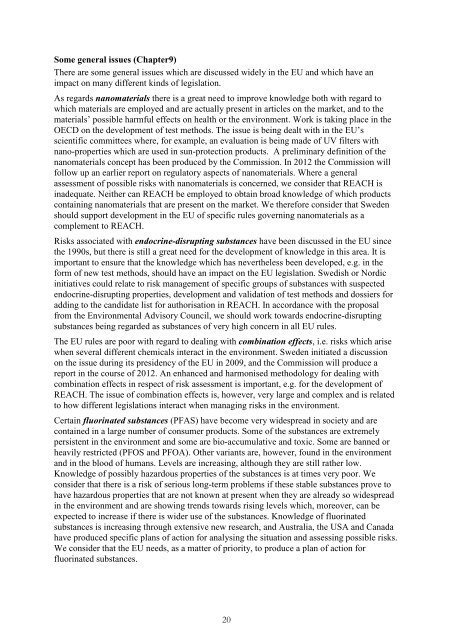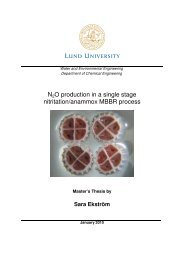Bättre EU-regler för en giftfri miljö - Kemikalieinspektionen
Bättre EU-regler för en giftfri miljö - Kemikalieinspektionen
Bättre EU-regler för en giftfri miljö - Kemikalieinspektionen
Create successful ePaper yourself
Turn your PDF publications into a flip-book with our unique Google optimized e-Paper software.
Some g<strong>en</strong>eral issues (Chapter9)<br />
There are some g<strong>en</strong>eral issues which are discussed widely in the <strong>EU</strong> and which have an<br />
impact on many differ<strong>en</strong>t kinds of legislation.<br />
As regards nanomaterials there is a great need to improve knowledge both with regard to<br />
which materials are employed and are actually pres<strong>en</strong>t in articles on the market, and to the<br />
materials’ possible harmful effects on health or the <strong>en</strong>vironm<strong>en</strong>t. Work is taking place in the<br />
OECD on the developm<strong>en</strong>t of test methods. The issue is being dealt with in the <strong>EU</strong>’s<br />
sci<strong>en</strong>tific committees where, for example, an evaluation is being made of UV filters with<br />
nano-properties which are used in sun-protection products. A preliminary definition of the<br />
nanomaterials concept has be<strong>en</strong> produced by the Commission. In 2012 the Commission will<br />
follow up an earlier report on regulatory aspects of nanomaterials. Where a g<strong>en</strong>eral<br />
assessm<strong>en</strong>t of possible risks with nanomaterials is concerned, we consider that REACH is<br />
inadequate. Neither can REACH be employed to obtain broad knowledge of which products<br />
containing nanomaterials that are pres<strong>en</strong>t on the market. We therefore consider that Swed<strong>en</strong><br />
should support developm<strong>en</strong>t in the <strong>EU</strong> of specific rules governing nanomaterials as a<br />
complem<strong>en</strong>t to REACH.<br />
Risks associated with <strong>en</strong>docrine-disrupting substances have be<strong>en</strong> discussed in the <strong>EU</strong> since<br />
the 1990s, but there is still a great need for the developm<strong>en</strong>t of knowledge in this area. It is<br />
important to <strong>en</strong>sure that the knowledge which has nevertheless be<strong>en</strong> developed, e.g. in the<br />
form of new test methods, should have an impact on the <strong>EU</strong> legislation. Swedish or Nordic<br />
initiatives could relate to risk managem<strong>en</strong>t of specific groups of substances with suspected<br />
<strong>en</strong>docrine-disrupting properties, developm<strong>en</strong>t and validation of test methods and dossiers for<br />
adding to the candidate list for authorisation in REACH. In accordance with the proposal<br />
from the Environm<strong>en</strong>tal Advisory Council, we should work towards <strong>en</strong>docrine-disrupting<br />
substances being regarded as substances of very high concern in all <strong>EU</strong> rules.<br />
The <strong>EU</strong> rules are poor with regard to dealing with combination effects, i.e. risks which arise<br />
wh<strong>en</strong> several differ<strong>en</strong>t chemicals interact in the <strong>en</strong>vironm<strong>en</strong>t. Swed<strong>en</strong> initiated a discussion<br />
on the issue during its presid<strong>en</strong>cy of the <strong>EU</strong> in 2009, and the Commission will produce a<br />
report in the course of 2012. An <strong>en</strong>hanced and harmonised methodology for dealing with<br />
combination effects in respect of risk assessm<strong>en</strong>t is important, e.g. for the developm<strong>en</strong>t of<br />
REACH. The issue of combination effects is, however, very large and complex and is related<br />
to how differ<strong>en</strong>t legislations interact wh<strong>en</strong> managing risks in the <strong>en</strong>vironm<strong>en</strong>t.<br />
Certain fluorinated substances (PFAS) have become very widespread in society and are<br />
contained in a large number of consumer products. Some of the substances are extremely<br />
persist<strong>en</strong>t in the <strong>en</strong>vironm<strong>en</strong>t and some are bio-accumulative and toxic. Some are banned or<br />
heavily restricted (PFOS and PFOA). Other variants are, however, found in the <strong>en</strong>vironm<strong>en</strong>t<br />
and in the blood of humans. Levels are increasing, although they are still rather low.<br />
Knowledge of possibly hazardous properties of the substances is at times very poor. We<br />
consider that there is a risk of serious long-term problems if these stable substances prove to<br />
have hazardous properties that are not known at pres<strong>en</strong>t wh<strong>en</strong> they are already so widespread<br />
in the <strong>en</strong>vironm<strong>en</strong>t and are showing tr<strong>en</strong>ds towards rising levels which, moreover, can be<br />
expected to increase if there is wider use of the substances. Knowledge of fluorinated<br />
substances is increasing through ext<strong>en</strong>sive new research, and Australia, the USA and Canada<br />
have produced specific plans of action for analysing the situation and assessing possible risks.<br />
We consider that the <strong>EU</strong> needs, as a matter of priority, to produce a plan of action for<br />
fluorinated substances.<br />
20















